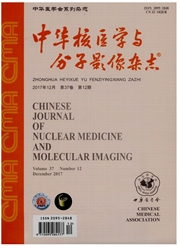

 中文摘要:
中文摘要:
目的研究制备针对骨髓基质抗原蛋白2(BST2)的TMBs造影剂(BST2-TMBs),通过超声分子成像技术对小鼠肿瘤血管内皮细胞进行检测,为肿瘤的发生、发展及早期诊断提供实验依据。方法将抗BST2的抗体通过生物素一亲和素桥接的方式连接于微泡(MBs)表面,获得BST2-TMBs,在光学显微镜下观察TMBs的形态,用粒径分析仪测定其粒径及其分布;通过体外细胞黏附实验研究TMBs与血管内皮细胞的结合性能,并对小鼠前列腺癌肿瘤血管内皮细胞行超声分子成像,用免疫组织化学染色分析BST2在肿瘤血管内皮细胞的表达。采用SPSS19.0软件行统计学分析,对独立样本行t检验。结果制备的BST2-TMBs的平均粒径为1.61μm,其中95%的微泡在1-5μm之间。BST2-TMBs能够与血管内皮细胞结合,平均每个视野有(165±25)个TMBs结合在内皮细胞表面,远高于非靶向微泡(IgG-MBs)对照组的(10±3)个微泡(t=10.662,P〈0.01)。黏附的TMBs能够明显增强内皮细胞的超声信号强度,TMBs为27.93±5.14(灰度值),非靶向微泡为3.61±1.67(灰度值)(t=7.239,P〈0.01)。小鼠在体肿瘤超声分子成像表明:BST2-TMBs处理组在微泡注射7min时信号强度(扣除微泡击碎后的信号强度)为38.79±0.29(灰度值),能保持47.65%的微泡注射30s时的信号强度(灰度值81.40±0.37),而IgG-MBs处理组在微泡注射7min时的信号强度(扣除微泡击碎后的信号强度)是9.46±0.17(灰度值),仅能保持11.39%的微泡注射30S时的信号强度(灰度值83.01±0.60)。相比之下,TMBs在肿瘤部位的超声信号强度较非靶向微泡提高4.27倍(t=65.587,P〈0.01)。免疫组织化学证实BST2蛋白在小鼠前列腺癌肿瘤血管内皮细胞上有表达。结论BST2-TMBs可以用于小鼠前列腺癌血管内皮细胞的超声分子成像,这为肿瘤的发生发?
 英文摘要:
英文摘要:
Objective To prepare the bone marrow stromal cell antigen 2 (BST2)-targeted micro- bubbls (BST2-TMBs) for detecting the vascular endothelial ceils of tumor via ultrasound molecular imaging technology. Methods The targeted microbubbles (BST2-TMBs) were obtained through linking anti-BST2 antibodies to the surface of microbubbles via biotin-avidin bridge. The morphology of TMBs was examined under microscope and size distribution was observed using an optical particle counter. The specific binding of TMBs to endothelial cells was detected by in vitro cell adhesion assay. Murine prostatic carcinoma was used to investigate the capability of TMBs in detecting the vascular endothelial cells and for validating the expression of BST2 proteins. The t test was used by SPSS 19.0 to analyze the data. Results The targeted microbubbles had the mean diameter of 1.61μm, with 95% microbubbles between 1 to 5μm. The in vitro cell adhesion assay demonstrated that the TMBs were able to specifically bind to the surface of endothelial cells, with (165±25) TMBs per field of view, significantly higher than that of the non-targeted rnicrobub-bles ( ( 10 ± 3) microbubbles per field of view, t = 10. 662, P 〈 0.01 ). The enhancement of ultrasonic sig- nals of these cells bound with TMBs was also observed (TMBs: 27.93 ± 5.14 (gray-level), non-targeted mi- crobubbles : 3.61 ± 1.67 (gray-level) ; t = 7. 239, P 〈 0.01 ). Significant enhancement of signal intensity(gray-level: 38.79 ±0.29 at 7 min, remaining 47.65% of that (81.40 ±0. 37) at 3U s) was found m the tumors of mice injected with BST2-TMBs, which was 4. 27-fold higher than that (gray-level: 9.46±0. 17 at 7 min, re- maining 11.39% of that (83.01±0. 60) at 30 s) of mice injected with non-targeted microbubbles ( t = 65. 587, P 〈 0.01 ). This finding was further confirmed through immunohistochemistry assay. Conclusion BST2- TMBs can be used for detecting the vascular endothelial cells of tumors via ultrasound mol
 同期刊论文项目
同期刊论文项目
 同项目期刊论文
同项目期刊论文
 Therapeutic Ultrasonic Microbubbles Carrying Paclitaxel and LyP-1 Peptide: Preparation, Characteriza
Therapeutic Ultrasonic Microbubbles Carrying Paclitaxel and LyP-1 Peptide: Preparation, Characteriza Computer-Aided Diagnosis Based on Quantitative Elastographic Features with Supersonic Shear Wave Ima
Computer-Aided Diagnosis Based on Quantitative Elastographic Features with Supersonic Shear Wave Ima Precise and programmable manipulation of microbubbles by two-dimensional standing surface acoustic w
Precise and programmable manipulation of microbubbles by two-dimensional standing surface acoustic w A TEXTURE MATCHING METHOD CONSIDERING GEOMETRIC TRANSFORMATIONS IN NONINVASIVE ULTRASONIC MEASUREMEN
A TEXTURE MATCHING METHOD CONSIDERING GEOMETRIC TRANSFORMATIONS IN NONINVASIVE ULTRASONIC MEASUREMEN Identification, characterization, and effects of Xenopus laevis PNAS-4 gene on embryonic development
Identification, characterization, and effects of Xenopus laevis PNAS-4 gene on embryonic development Adenovirus-mediated combined anti-angiogenic and pro-apoptotic gene therapy enhances antitumor effic
Adenovirus-mediated combined anti-angiogenic and pro-apoptotic gene therapy enhances antitumor effic Reversal of multidrug resistance phenotype in human breast cancer cells using doxorubicin-liposome-m
Reversal of multidrug resistance phenotype in human breast cancer cells using doxorubicin-liposome-m Paclitaxel-liposome-microbubble complexes as ultrasound-triggered therapeutic drug delivery carriers
Paclitaxel-liposome-microbubble complexes as ultrasound-triggered therapeutic drug delivery carriers Multi-scale patterning of microparticles using a combination of surface acoustic waves and ultrasoni
Multi-scale patterning of microparticles using a combination of surface acoustic waves and ultrasoni On-chip targeted single cell sonoporation with microbubble destruction excited by surface acoustic w
On-chip targeted single cell sonoporation with microbubble destruction excited by surface acoustic w Measurement of flow velocity fields in small vessel-mimic phantoms and vessels of small animals usin
Measurement of flow velocity fields in small vessel-mimic phantoms and vessels of small animals usin Transportation of single cell and microbubbles by phase-shift introduced to standing leaky surface a
Transportation of single cell and microbubbles by phase-shift introduced to standing leaky surface a 期刊信息
期刊信息
